|  
IN THE NEWS | ELECTION 2002 | CALENDAR
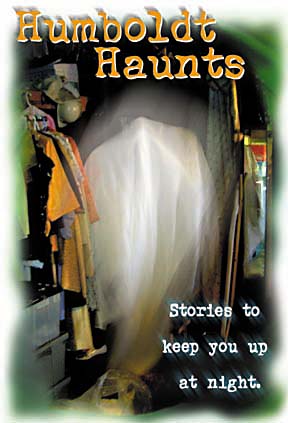
A Ghost Hunt | Righting past wrongs | The Pink Glow
Ghostly Ferndale | A ghost named Ralph
Rocky and his friends | Things that go bump in the night
Spirit world do's and don'ts | Other haunts
I am thy father's spirit,
Doomed for a certain term to walk the night,
And for the day confined to fast in fires,
Till the foul crimes done in my days of nature
Are burnt and purged away. But that I am forbid
To tell the secrets of my prison house,
I could a tale unfold whose lightest word
Would harrow up thy soul, freeze thy young blood,
Make thy two eyes like stars start from their spheres,
Thy knotted and combined locks to part,
And each particular hair to stand an end
Like quills upon the fretful porpentine.
But this eternal blazon must not be
To ears of flesh and blood... WILLIAM SHAKESPEARE, Hamlet WE CAN'T PROMISE THAT THE FOLLOWING STORIES will be quite so chilling as the ones that the ghost of Hamlet's father could have told, but we think they're pretty scary nonetheless. Or at least entertaining. You'll meet Ralph, the friendly ghost purported to reside at the Morris Graves Museum of Art; Bertha, a mischievous spook who enjoys goading folks at the Ferndale Repertory Theatre; and Heidi Monteverde, a medium for whom interacting with the spirit world is just part of the daily routine. One tale has nothing to do with Humboldt County. We decided that didn't matter. Ghost stories are universal, after all -- they're essentially about the dead, and we all die. And while it may sound strange, they also have religious implications -- if the dead really come back as spirits, then there is an afterlife. Maybe that's why ghost stories can provoke such strong reactions, from fright to outright rejection. Even those who are merely amused by them can, with the right story and under the right circumstances, fall under their spooky sway. They have a way of getting inside our heads, of forcing us to read or listen to them even when we don't want to. Yes, part of the attraction is simply morbid curiosity. But ghost stories are irresistible in a more profound way -- they awaken something ancient, a deep-seated sense that lurking all around us is an invisible world populated with invisible beings. Occasionally, we feel them and even see them, or at least believe we do. And when that happens the thrill is excruciatingly sharp. The hairs on our head may not stand up, but the hairs on our neck certainly do. So read on, enjoy and if you can't fall asleep tonight, don't blame us. You've probably got a ghost.
-- Keith Easthouse
A Ghost Hunt by ANDREW EDWARDS "OH, HELLO," MEDIUM HEIDI MONTEVERDE SAID LOOKING around and smiling, seemingly at thin air, as we walked into the 90-year-old Clarke Memorial Museum on E Street, in Old Town Eureka. 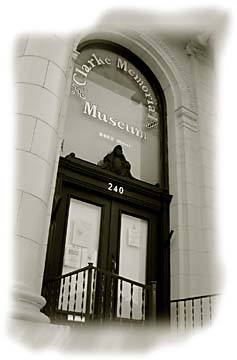 I'd met Monteverde at 321 Coffee in Old Town an hour before to talk about ghosts, hauntings and the spiritual world in general from the perspective of a professional medium. Now we had ventured out, with the goal of doing a "walk through" of a haunted Eureka building to hunt out all of the spirits we could, not to catch them or "bust" them or anything, just check `em out. Kind of a spiritual social call. I'd met Monteverde at 321 Coffee in Old Town an hour before to talk about ghosts, hauntings and the spiritual world in general from the perspective of a professional medium. Now we had ventured out, with the goal of doing a "walk through" of a haunted Eureka building to hunt out all of the spirits we could, not to catch them or "bust" them or anything, just check `em out. Kind of a spiritual social call.
So, the skeptical reporter and the flamboyantly dressed medium descended on the museum determined to see what we could see. She'd told me she'd just lead us around from ghostly energy center to ghostly energy center, and then she'd tell me what she saw. We'd try to take in as much of the entire building as possible. "I'm one of the most thorough mediums I know," she said on the way over. It was a gray, Humboldt sort of day and inside the museum was bathed in a neutral, flat-white light from the skylights that make up most of the ceiling. The display cases spread out before us in a sort of antique-packed, counter-level maze. Monteverde immediately headed over to one side of a central room, pausing in front of an old photograph. It depicted a logging railroad and a swath of forest in the process of being harvested. "This looks like the way things were when this building was erected," she said. She looked closer at the date in the lower left-hand corner of the black-and-white photograph. "1912, that must be when this building was erected." I asked why she had gone over to the photograph. "Spirits are attracted to photos that remind them of things when they were alive," Monteverde said. She motioned at a display of period clothing across the aisle we were in. "And [to] objects that were familiar to them in life." Like clothes? "Like clothes." She explained that ghosts like to hang out in museums for several reasons. First, there aren't many living people in museums -- and therefore there's less confusion. Secondly, museums are full of things that the ghosts may have actually used in their own lives, things that they find comfortable and reassuring. And finally, of all the buildings a ghost could happen upon, museums are most free of modern technology, which confuses and frightens them. "Unless it's electrical," she said, as we continued on our tour. "Computers, televisions, telephones. They like electricity. It excites them." 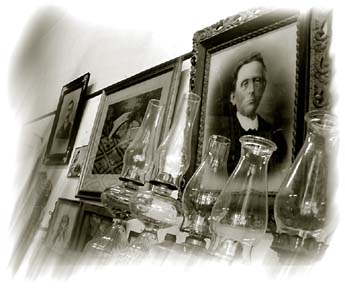 So Poltergeist wasn't as far off as I'd thought. (Remember the television?) So Poltergeist wasn't as far off as I'd thought. (Remember the television?)
We moved into a darkened alcove decorated like a turn-of-the-century sitting room. Prime spiritual real estate. At this point a museum docent, an older woman, thin with glasses, had attached herself to our discovery party, listening. There was a ghost, several in fact, Monteverde was saying. There was one spirit, a woman, who very much liked the piano (it stood against one wall of the alcove), and "the smell of violets." There was also a man with glasses standing next to a large multi-drawer desk (also in the alcove). He was, perhaps, a banker. I asked her how she saw them, what it was like. "I see through their eyes for an instant, it's like becoming the person," she said. "It's very dangerous for people who are inexperienced to try this." Then she looked down. "There's a large concentration of spirits right here, underneath us," she said, tapping her foot on the ground. Our museum-affiliated shadow said that directly under us was the museum basement, where toxic, stuffed birds in piles of plastic bags and other objects were stored. She said we could check it out if we wanted. I had just discovered the secret to getting full access to a museum: Bring a medium along. On the way, Monteverde noticed a large wooden record player. Touching it, she said a spirit was very attached to it. The docent smiled tightly. Then both Monteverde and I noticed the "Do Not Touch" sign. Oops. Our guide explained that the building had been built as a bank in 1912 (just like Monteverde had said!) to replace an older banking establishment that had stood in the same location. The basement was behind the museum office down a flight of cement stairs. It had exposed, low piping and was indeed filled with bags of dead birds, unidentifiable junk and a few ancient-looking tricycles. Monteverde said there might be as many as seven spirits down there, but that they were very confused about the change in the buildings and were from an earlier time than the building itself. The one she could identify was a man in a suit with a small watch and chain attached. He was wearing a bowler and liked to smoke cigars. "A definite male presence," she said. At this point another museum staffer had joined us, Lynn Wellman, volunteer coordinator and assistant registrar. She said she had been working upstairs in the clothing collection that morning and felt a little funny. So upstairs we went. The first stop at the top of the stairs was the old bank vault. Over the door was a panel painting of a cocker spaniel, its brown eyes staring off into space. Inside the box of a steel room were open racks with a hodgepodge of items from the museum's collections stacked on them. "I hear people counting over and over," Monteverde said, looking around. "Back there someone's writing in a ledger." She said the counting sound was probably a haunting, an echo of the work that used to be done here, as opposed to an active spirit, and that in general the vault was a very powerful place, spiritually. "My chest constricts when I come in here," she said. As I joined her in the vault -- and I don't know if it was just in reaction to her or what -- my chest seemed to tighten up over my sternum as well, the same high, butterfly feeling I get when I'm in a jet that's accelerating for take off. Maybe it was the power of suggestion. She said there was an active spirit in here too, but it was hard to pin down. All she could get was the sound of shuffling, as if the spirit was older and had trouble walking, and a musty, medicine smell. After the vault, Wellman led us down the hall to what used to be two women's restrooms. The first was stocked with guns. Rifles lined two walls with cabinets of handguns, all sorts, on the other two. This room, according to Monteverde, was the most powerful we had been in so far. With racks of old weapons, some of which, according to our host, had been used in the Civil War, all kinds of spirits were "manifesting." She said mostly military personnel were attracted to guns, but the people they had killed were attracted to them as well. She said she could spend a whole day just dealing with the ones in here, and that a lot of them were trying to communicate. She offered to come back and do specific object readings when she had the chance. The next room, the other ladies' room with the sign still on the door, contained rows of stacked paintings and a pile of furniture. "There's a lady here, wearing red or purple," Monteverde said. "She's got light-colored hair, either blonde or gray and a pin at her chest, gloves, boots with little hooks, and a parasol." She said the ghost was happy, but that she wanted one of the chairs in the pile to be set up so she had somewhere to sit down. Wellman said she'd do something about that. Finally, we went to the textile room at the other end of the hall, back past the vault. The room was full of clothing hanging in white garment bags (just the way ghosts like it, Monteverde said -- stacked clothing bothers them for some reason). Wellman had been marking and categorizing them, which Monteverde said was good, the ghosts wanted it done, and that they would like to help her out if they could. With the second story pretty well covered, we went back downstairs. We briefly went into the Indian room, where, Monteverde said, the spirits from the five tribes represented -- the Hupa, Yurok, Karuk, Wiyot and Tolowa -- were in perpetual dissent over the display of their items. Monteverde gave her card to the museum staff, and asked them to call her if they needed any spirit-related assistance. And then we headed for the door -- and saw one last thing. "That dress is haunted," Monteverde said, pointing at a white lace dress in a plate-glass display case as I held the door. And thus ended our social call, at what seemed to be a very ghost-packed museum. As we walked away, Monteverde turned back and smiled. "I feel that the spirits are really happy that we came in there," she said. I was glad for that; it's always nice when you leave your hosts happy.
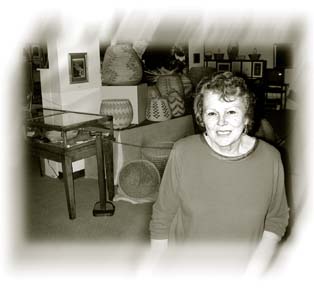 Righting past wrongs Righting past wrongs
There is still some dissatisfaction on the part of tribes (and possibly tribal spirtits) about the display of artifacts in the Native American collection in the Clarke Memorial Museum, but nothing like it used to be. "There was a time when the Native American people were very unhappy about [the Native American collections room]. They felt that the baskets and other things here were being held captive; they didn't like to see them behind glass," said Rosemary Hunter [in photo at left], a long-time museum volunteer who, in her words, definitely has "the ability to see the spirit world." She said that the problems had arisen because Native Americans viewed the objects -- bows, obsidian blades, baskets and jewelry -- as things that have a life of their own and need to be used. She said angry Native American spirits abound in the region -- in no small part because the injustices and massacres perpetrated on Native Americans in Humboldt have left a spirit population that is still here trying to set things right. "Because of the injustices to the Indian people there is a lot of pain," Hunter said. "Spirits hang on hoping to make it right and set nature back in its proper balance." So how did things change for the better at the museum? 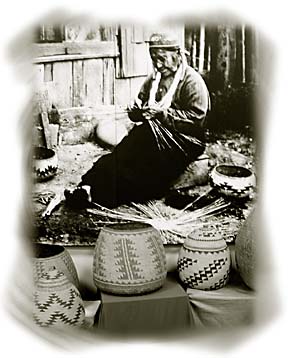 According to Hunter, the museum made a conscious effort to involve the Native American community in its operation. They advise on the proper display of artifacts and have an open invitation to come in and care for them. According to Hunter, the museum made a conscious effort to involve the Native American community in its operation. They advise on the proper display of artifacts and have an open invitation to come in and care for them.
"People come in to visit things, talk to them and hold them, sing to them," Hunter said. A Hupa, Vernon Bradley, serves on the museum's board of directors. Hunter said that he, too, can sense the spirits, and that when there's a problem the two of them walk over to the source of the distress right away, sensing the spiritual disturbance. One might think seeing spirits would be a strange thing, but Hunter says it's just a part of who she is. "It's as much a part of my life as eating," Hunter said. She explained that she was raised, in part, by her Cherokee grandmother, who also saw spirits, so she never thought it was weird. "It's like anything else, if you're raised with it." -- Andrew Edwards
The Pink Glow by KEITH EASTHOUSE THIS HAPPENED 12 YEARS AGO, IN SANTA FE, N.M. My girlfriend (later to be my wife) Gigi Espinoza and I had agreed to housesit for a couple we knew. It was a long gig -- they were going to be away for three weeks. It was a cute place, a converted basement built into a hillside. The main house was upstairs. Greg and Anne said not to worry about it; it was all locked up, the owners didn't live there anymore. For a week or so we didn't notice anything strange about our temporary digs. In fact, we enjoyed living there. Located at the end of a long winding driveway off Upper Canyon Road on Santa Fe's mostly exclusive east side, the sloping wooded property had a secluded feel about it. Whoever owned the place had money, we said to each other. Like everything else in the apartment, the kitchen was tiny. It was divided from the living room by a partition that had entrances on either side so that if for some reason you wanted to you could walk in circles going from the small sitting area in front, through the kitchen, out into the narrow hallway, and then back to the sitting area. The bedroom was on the other side of the hallway and also had two entrances, a regular doorway next to the side of the bed and, beyond the foot of the bed, French doors that opened onto what passed for the living room. It was all a bit cramped, but we thought very cozy. The first time I felt uncomfortable was late at night when I was going through my ablutions in the bathroom before bed. Gigi had already retired, so I was the only one up and about. I was brushing my teeth when I first had the sensation of being watched. I didn't conceptualize it that way -- not then. I just felt edgy. I finished brushing, splashed my face with water and, deciding that the best way to conquer fear is to stare it down, ventured into a part of the apartment I hadn't been in much before -- the very back of it, which was completely underground and cluttered with boxes. I'm afraid of heights but I'm not at all claustrophobic; I enjoy caves. But somehow this particular cave didn't agree with me. The further back into it I went, the more jumpy I became. It was like I was in enemy territory and something was about to leap out at me. I felt extremely wary and didn't stay back there long. It was, in a word, spooky. A couple of days later I went back into the apartment's nether regions again -- in daytime -- and didn't feel much. But nonetheless something had changed -- it was an awareness on my part, but an awareness of what? I finally confided my edginess to Gigi, who, to my surprise, said that she had also been feeling weird. She said that the back of the apartment felt particularly uncomfortable, as if it contained an "evil pressure." Once, she went back there in search of the cats we were taking care of and had to walk back out quickly when she felt panic rising inside her. For the rest of our time in the apartment, we felt uneasy. I began to get the feeling I was being watched, particularly when I stood in the kitchen or the bathroom. I definitely sensed a presence -- it seemed to be in the doorways -- but neither of us could see or hear anything, until one of our last nights there. The experience was not terribly dramatic. I simply woke up one morning very early, it was barely dawn, and saw a pink glow near the French doors at the foot of the bed. I didn't feel frightened, as I had in the back of the apartment. In fact, I felt quite calm. I stared at the glow for as long as I could, thinking that if I blinked it would disappear. But when I finally blinked it didn't disappear. I tried looking away and then looking back -- and still it was there. Very slowly, over what must have been a minute or more, the glow faded. Then it was gone. I told Gigi about it over breakfast. To my amazement, she had had a similar experience. She'd had a dream that a woman in a white nightgown was watching us as we slept. When she awoke, she too saw a pink glow -- in the doorway leading out to the hall. She didn't feel any menace or danger, saying that "her spirit felt very self-contained." When Gigi blinked, the pink glow abruptly disappeared. When Greg and Anne finally returned, we told them about the dread we had felt and about the "visit." They were not at all surprised. "We didn't know whether to tell you guys or not," said Anne. They'd never seen anything, but they often heard noises in the main house upstairs, "like someone moving furniture." 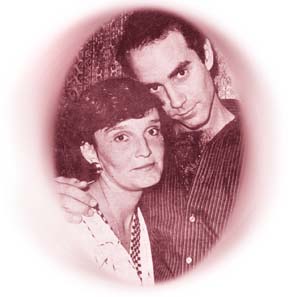 "Who lives there?" I asked. No one, Anne said. The owners died in a plane crash a few years ago; all their stuff is still up there covered in sheets. "Who were they?" I wondered. "Scott and Vivien Gershen," Anne replied. "Do you know who they were?" "Who lives there?" I asked. No one, Anne said. The owners died in a plane crash a few years ago; all their stuff is still up there covered in sheets. "Who were they?" I wondered. "Scott and Vivien Gershen," Anne replied. "Do you know who they were?"
I had to sit down. I was stunned. As a staff writer with the Santa Fe Reporter, a weekly newspaper, I had written a cover story about the Gershens after the plane they were passengers on struck a mountainside in Burma. They were there on vacation and when news of the tragedy spread through Santa Fe, their many friends spontaneously threw a party in their honor that attracted more than 150 people. Scott had been a prominent member of Santa Fe's alternative healing community, while Vivien had been a vivacious Realtor, "the most outgoing person on the planet," as one friend, Judy Margolis, had put it when I had interviewed her. Somehow I knew with a certainty that the presence in the apartment had been Vivien. [The Gershens at right, photo from the Santa Fe Reporter] When we got home I immediately dug out the paper, dated Oct. 21, 1987. It had been three years and I had forgotten most of the details, so I read the whole thing over -- a long main piece and a sidebar. It didn't take me long before I remembered something. Margolis had told me off the record that before they left Santa Fe Vivien had had a premonition that she and Scott would not return from their vacation, that they would die over there. Another friend had mentioned something else, in an offhand way, about Vivien, something that hadn't seemed terribly important at the time but seemed remarkable now, something that underscored her flamboyant personality. Vivien had been nuts about the color pink. Footnote: A few years later I drove a couple of friends to the Gershens' property. It was after midnight, and I told the tale as we sat in my car parked halfway up the sloping driveway, just far enough to get a glimpse of the apartment, but not so close that anyone could see us trespassing -- if anyone was living there. When I got to the punch line about Vivien's favorite color, something unaccountable happened. The car, a stick shift that was in first gear with the emergency brake on and the engine off, suddenly lurched backward. It felt for all the world as if a "pressure," to use Gigi's word, was trying to shove us out of there. I started the engine, put the car in reverse, and hurriedly complied.
Ghostly Ferndale by ANDREW EDWARDS 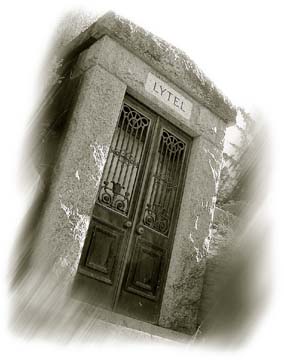 EVERYONE KNOWS (OR AT LEAST SUSPECTS) that ghosts love Victorians. They're old, they're squeaky, they're spooky-looking at night. So where better to look for ghosts than the Victorian Village of Ferndale? EVERYONE KNOWS (OR AT LEAST SUSPECTS) that ghosts love Victorians. They're old, they're squeaky, they're spooky-looking at night. So where better to look for ghosts than the Victorian Village of Ferndale?
Beyond a great concentration of some of the oldest buildings in Humboldt, Ferndale has one of the most eerie cemeteries this side of the Redwood Curtain. There have been rumors (and in one instance a police report) of witchcraft among the graves. Part-time Ferndale resident and artist Hobart Brown's legendary Halloween parties, thrown at his gallery in town and at the Benbow Inn, sparked rumors of Satanism and the occult that have never quite died down. The Gingerbread Mansion bed and breakfast is listed in several guides to America's most haunted inns. But arguably the most prominent ghost in this sleepy town of 1,300 souls is Bertha, the spirit reputedly haunting the Ferndale Repertory Theatre. "I've been at the Rep or working at the Rep since `82 and I've had things happen during productions that were inexplicable," said Ferndale Rep Executive Director Marilyn McCormick. Bertha is, allegedly, the ghost of Bertha Russ Lytel, a Ferndale matriarch who died in 1972 at the age of 98. The legend goes that she had always wanted to be in the theater when she was young, and so when she died she took up residence in an old room off the main dressing area that harbors the Rep's circa 1920s oil heater, and, appropriately, lies behind a mirror. She has haunted the place and made mischief with productions ever since. She is reported to be a meddlesome, if generally good-hearted, ghost and tales of her exploits abound among long-time Rep staff. One night Denice Riles was coming in to work late in the costume shop. She walked up the stairs, past the light booth and was about to open the door to the shop when she heard a voice coming from the other side telling her not to come in. Riles, who thought the room should have been empty at that late hour, decided to err on the side of caution. She turned around and left.  One of the more inexplicable cases involved the bathroom connected to the greenroom (where actors hang out and get ready during shows). One of the more inexplicable cases involved the bathroom connected to the greenroom (where actors hang out and get ready during shows).
The actors came off stage from curtain call after a successful performance only to find that the bathroom door was locked from the inside. They banged and banged on the door, until they realized there wasn't anyone in there. Adding to the puzzle was that the one window to the tiny bathroom was also locked. They ended up having to force that open and hoist the smallest member of the cast through it to get the bathroom door open. [the bathroom door latch is pictured at right] When Bertha appears, as she reportedly has on several occasions, she is seen as a kind of (you guessed it) "ghostly light," but more often only the effects of the whimsical spirit's actions are in evidence. Once, a show required a shot to be fired in the distance, and the logical place to fire a shot and produce that effect for the audience was Bertha's room. When the stage manager opened the door and fired the shot in the first performance, everything went off as planned. But afterwards a series of minor accidents plagued him, including spraining the finger that had fired the shot. "Of course he blamed it all on Bertha," McCormick said. 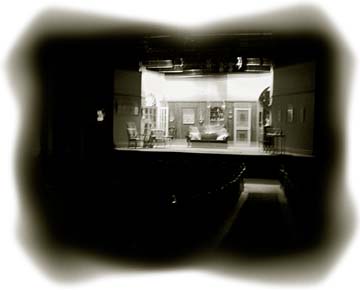 The last thing any theater needs is an angry ghost, so casts always make sure they let Bertha know she's wanted. The last thing any theater needs is an angry ghost, so casts always make sure they let Bertha know she's wanted.
"At the beginning of each show we always look up into the theater and say, `We love you Bertha, you're welcome here,'" McCormick said. So far it has seemed to work, because even though there are minor unexplainable quirks -- particularly with the computerized lighting on opening nights -- nothing really bad ever seems to happen. McCormick recounted one time when a backdrop that had been rolled up above the stage came crashing down in the midst of a performance, even though it had been double-checked several times before the show. No one was hurt, although the backdrop narrowly missed one member of the cast. Right now the theater staff is worried a bit because one of the upcoming plays this season is Blithe Spirit, a ghost story, and they're not sure how Bertha is going to react. "I'm anxious to see if [the show] is going to trouble her or make her feel at home," McCormick said. "I'll guess we'll just have to wait and see."
A ghost named Ralph by ANDREW EDWARDS 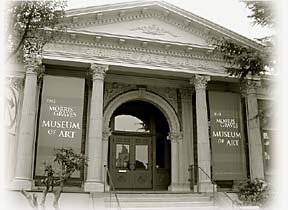 IT ALL STARTED IN 1972 WHEN CLAUDIA, a former employee of the Carnegie Library in Eureka, was down in the basement searching for some magazines that had been requested. Suddenly, she felt a pull on the hem of her sweater from behind as if someone were trying to get her attention. When she turned around, no one was there. IT ALL STARTED IN 1972 WHEN CLAUDIA, a former employee of the Carnegie Library in Eureka, was down in the basement searching for some magazines that had been requested. Suddenly, she felt a pull on the hem of her sweater from behind as if someone were trying to get her attention. When she turned around, no one was there.
She told her ghost story to all of her co-workers and things just took off from there. Footsteps on the stairs, a tap on the shoulder, doors opening and closing, lights turning on and off -- the usual ghostly tricks. One young woman, who didn't want her name to appear in this article because she didn't want people to think she was a "freak," described an incident she experienced as a 9-year-old that she has never forgotten: Alone in the basement looking for a book, she saw a chair standing balanced on its back two legs in the middle of the room. According to one newspaper article from the 1970s, janitors were afraid to work alone at night, and librarians dreaded turning the lights off when they were locking up. Finally, one brave employee decided to take a stand and find out just who or what was behind all of the commotion. She and a friend, armed with a Ouija board, held a midnight vigil in the library to summon the restless spirit and ask it what was going on. He came, but all they got out of him was the name he has been known by ever since: Ralph. Since 2000, when the Humboldt Arts Council moved into its new digs in the basement of what is now the Morris Graves Museum of Art, stories have multiplied along with the new activities. The council's executive director, Guy Joy, speculated that maybe the building's new life had reawakened its spirit. 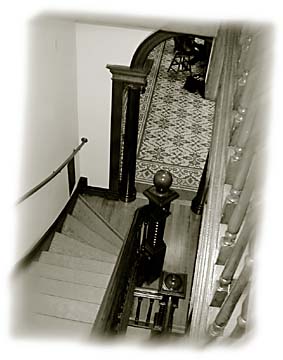 "Think of the changes that have happened here over the years," Joy said. "It went from a vacant lot, to a library, to a museum and performance venue with over 50 live performances a year. That's a lot of noise in here, and a huge change in the energy level." "Think of the changes that have happened here over the years," Joy said. "It went from a vacant lot, to a library, to a museum and performance venue with over 50 live performances a year. That's a lot of noise in here, and a huge change in the energy level."
While the museum was being restored a few years ago an elderly couple was inspecting the progress of the renovation, towards which they had donated generously. Finally, they were touring the basement and walked into a back room -- the stacks, the same room that Claudia had been accosted in. "They walked in, turned around and walked right out," Joy said. "They were white as sheets." They had seen Ralph, lying there on what should have been empty shelves, stiff as a board. When they looked back he was gone. Joy said that one former arts council official was working in her office in what is now the Balabanis Gallery in the upper part of the museum when, suddenly, objects started flying off the top of the bookshelves into the center of the room. Unnerving, to say the least. According to a museum booklet, Ralph was invited to follow the Carnegie Library's book collection to its new location at the Humboldt County Library on 3rd Street. Apparently, though, it wasn't the books, but the building Ralph felt attached to. One can see why. From the uniquely patterned pine slat floors to the tight-grained, old-growth redwood columns that rise up to the domed central skylight, the turn-of-the-century classical revival building almost looks like a temple. It simply cries out to be haunted. And Ralph has answered the call. Everyone has a story. The room the old couple had their encounter in was later converted into an art classroom. One night another council official was working late, and, of course, alone. She was walking out to leave the building when she saw a name scrawled in blue chalk or paint (depending on who tells the story) on the classroom's cement floor: Ralph. Joy said one night last February he was working late when he noticed the lights were on in the classroom. He got up and turned them off to save energy and went back to his work. After a while he looked up and they were on again. No one else was in the building. The museum's temperature and humidity are regulated to preserve the artwork on its walls, so it is important to keep all of the doors closed. One time Cory Gundlach, the exhibitions coordinator, came in to work to find that the doors had been propped open with rubber stops. He muttered something under his breath about how he really wished someone would remember to close the doors around here, and went into another room. When he came back, the doors were closed. Footsteps heard on the gallery floors above by people who are working alone in the basement are so common that no one even finds them worth mentioning anymore. It's just part of the job. "I always hear strange thuds and cracks when I'm in here by myself," Gundlach said. "I just think it's the building settling." Joy pointed out that the building's cornerstone was laid 100 years ago, and there's probably not much "settling" left to do. To his mind people who try to explain Ralph away are wasting their time. "I'm open to anything. It doesn't matter if it's imagination or the life of the building," Joy said. "(But) people who claim they know everything that could possibly be going on don't know what they're talking about." Overall, people who work at the museum don't seem particularly disturbed by Ralph, who is considered a happy spirit, almost a good-luck charm. "My thought is that it [Ralph] is someone who has something to do with the building itself, someone who really cared about it," Joy said. "When it appears, people never feel bad, there's never fear or terror. I think the spirit's really happy. It's glad we're taking care of its home."
Rocky and his friends 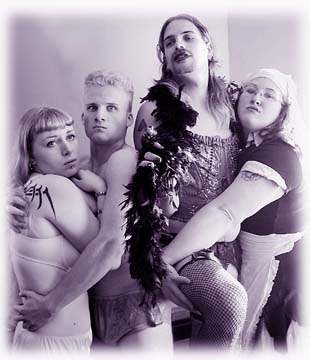 It was just before midnight on a foggy Wednesday and the streets of Arcata were quiet. There was a big crowd across town at City Hall where Iraq was the topic of discussion, but for the half-dozen people smoking and chatting outside the Minor Theater, talk focused on the upcoming showings of the sci-fi musical The Rocky Horror Picture Show, arguably the ultimate cult film. It was just before midnight on a foggy Wednesday and the streets of Arcata were quiet. There was a big crowd across town at City Hall where Iraq was the topic of discussion, but for the half-dozen people smoking and chatting outside the Minor Theater, talk focused on the upcoming showings of the sci-fi musical The Rocky Horror Picture Show, arguably the ultimate cult film.
At the center of the group were two women: Alyse, a stunning blonde with a ring in her nose who wore a floor-length trench coat over a black vinyl evening gown, and Keila, a brunette, who was shivering in an unzipped sweatshirt worn over a black strapless bra and a micro-mini skirt. They were recently appointed co-directors of a makeshift troupe known as Psychotic Cabaret, one of many Rocky Horror "shadow casts" who lip-sync and dance along with the movie. And they were here to lead the cast in a rehearsal. [four members of the cast in photo at right] The Rocky Horror Show started life as a musical created for the London stage spoofing the sci-fi horror film genre. When the show was transformed into a film in 1975, it was not an instant box office success. However, over time the film gained momentum as it mutated into a midnight movie with a cult-like audience. The film's images, songs and dialogue were augmented with shouted jokes and comments to form an elaborate subtext. People came in costume bringing props: rice for a wedding scene, squirt guns to simulate rain and toast for a toast. Attendance became an interactive experience. While Rocky has always been a traditional staple of the Halloween season, many theaters began showing it every Saturday night at midnight. And all across the United States, serious cult members put together complete casts who dress as specific characters and pantomime the entire movie in front of the screen week after week. "I started going to Rocky Horror when I was like 13," recalled Alyse, who grew up in Southern California. "My mom used to go a lot, she showed me the movie when I was maybe 10. When I first saw it my initial response was, `Ugh, how could anyone like this?' But then my friends took me to an actual live show and I was hooked. "After a while I would go every weekend. At first it was like, `There's nothing to do, let's go to Rocky,' but then it became this ritual. When I moved up here [in 2000] I went to see it on Halloween, but there was no cast. I was confused, it just wasn't the same thing." There was another Southern California transplant in the audience that Halloween, a woman who went by the name of Gatsby. Like Alyse, Gatsby started attending screenings while she was a teenager. "There was this incredible variety of absolute freaks," she said the other night. "Everyone was doing what they wanted to do. I went with my friends and screamed, yelled and threw things. By the middle of the week I had a craving to go again, then I just kept going and going." After a while she found herself directing a weekly performance in Redondo Beach. When she moved to Humboldt she became a self-confessed "cult leader" by starting up a Rocky cast here. Alyse and Keila were among those enlisted. Now Gatsby is trying to hand over the reins, in part because she is tired of being "pegged as the girl who does Rocky." Out front of the Minor, Alyse and Keila discuss the casting for the three Psychotic Cabaret-accompanied shows coming up: two midnight shows on Friday and Saturday and a 10:30 p.m. screening on Halloween. The movie's slightly silly story line concerns two "ordinary healthy kids," Brad (Barry Bostwick in the movie) and Janet (Susan Sarandon), who end up at a spooky castle on a dark and rainy night. Greeted by a butler and maid, Riff Raff (Richard O'Brien, who wrote the original play) and his sister Magenta (Patricia Quinn), Brad and Janet are stripped to their underwear and introduced to "the master," Dr. Frank N. Furter (Tim Curry), a bisexual transvestite in sequined bustier and fishnet hose who comes from the planet Transsexual in the galaxy of Transylvania. It seems Brad and Janet have arrived on "a rather special night." Frank is about to unveil his latest creation, Rocky Horror (Peter Hinwood), a blonde boy toy he has cooked up in the laboratory. Before the party is over they have all shared a cannibalistic feast, Frank has seduced both Janet and Brad, and Janet has seduced Rocky. Psychotic Cabaret's shadow cast will rotate nightly with three different Franks: one night it will be a Mohawked punk rock guy known as Mom; Hans, a clean-cut college boy, plays him another night; and P.C. founder Gatsby will play Frank on Halloween. It might seem odd that a woman would play a man who dresses as a woman. But Alyse explained it's all part of the game. "The whole thing is about gender-bending," she contended. Her co-director Keila will take the role of the male criminologist who provides narration between scenes all three nights. And Alyse? She plays Janet over the weekend, but she's Rocky on Halloween. No rice, please "Truly amazing," said David Phillips, describing the Rocky Horror phenomenon. Phillips owns and operates the Minor Theater along with the Broadway and The Movies at the Bayshore Mall. He has shown the movie regularly since the '70s. He pointed out that with adjustments for inflation, the film has brought in the equivalent of $354 million and ranks No. 30 among the highest grossing films of all time. Until recently, Phillips also owned the Arcata Theater, the primary venue for Rocky Horror. When he sold the movie palace earlier this year, he wrote a clause into the contract giving him the sole right to show Rocky Horror in Arcata. There has been some talk of screening the film at the Eureka Theater, and the Psychotic Cabaret cast would love to see it shown there as a regular event. Phillips thinks that would be a bad idea -- and not just because of the competition. "You have to know what you're doing when you put on Rocky," he asserted. "If you don't, you're going to regret it. Your theater can get thrashed. And with the casts, well, you have to recognize that it's an unusual group of people who do it. You have to work with them and monitor them because they will constantly push the envelope." When the film is shown at the Minor this weekend and on Halloween, Phillips will beef up security and search attendees at the door. They will be looking for contraband: smuggled booze, and also some items that are classic Rocky props. "We ask people not to bring in water-guns, rice, toast and things like that that are going to cause a huge mess," said Phillips. "All of those things are traditional props, but we've experienced them and they have created havoc." -- Bob Doran
Things that go bump in the night Kareen woke up in the middle of the night sweating. She opened her eyes slowly, and saw a shadow on the ceiling of her second-story bedroom. She froze and closed her eyes again. She peeked. It was still there. Again. Still there. Again. It was gone. At this point she was spooked. Her Victorian house in Eureka had always been a little spooky. But she'd never felt like this, irrationally afraid. So to calm herself down she called a friend. As she talked, she suddenly heard ranting from the street below her window. "I'm going to kill you! I'm going to kill you!" the voice was screaming. She hung up and called 911. "If it'd just been ranting about the aliens landing or something I wouldn't have done anything, but to say that was a bit much," Kareen, who didn't want her last name used, said. The sound died down as the ranting voice disappeared down the street. After a while, she went back to sleep -- only to awake moments later to a thud from her living room, and then another. "It sounded as if someone was jumping up and down and throwing themselves into the walls," Kareen said. She called the Eureka police department. They came only to discover that there was no one there, and what's more nothing was broken or even disturbed in the living room. Still Kareen was spooked. A few days later she called over a friend who was "sensitive." He said that the angry-looking statue of the Hindu god Ganesh that was on prominent display in her living room really bothered him. So they went outside and smashed the statue. After that the disturbances ceased. -- Andrew Edwards
Spirit world do's and don'ts ORIGINALLY, HALLOWEEN WAS CELEBRATED AS Samhain, the day before the Celtic new year, when the veil between the world of the living and the dead is thinnest. Costumes were worn to scare away any bad spirits that might make it through. But in case your costume isn't quite scary enough, here's some advice from two local mediums. First of all... There is a difference between a spirit and a haunting (one is a person, only dead; while the other is an energy residue from a past event that repeats itself when something triggers it). But generally, they can be dealt with in the same ways. To wit: IF YOU'RE BEING HAUNTED BY A FRIENDLY GHOST: ADVICE: Accept it and enjoy it. WHY: If you're frightened or disturbed by a friendly ghost, you'll make it feel bad (think of Casper). "Basically when [a positive spirit] manifests, it is trying to help," said medium Heidi Monteverde of Eureka. "If you fear [a spirit that is] positive it will feel guilty and get depressed, just like a person." IF YOU'RE BEING HAUNTED BY A NOT-SO-FRIENDLY GHOST: ADVICE: Ignore it and it will go away. WHY: Angry or mean ghosts generally enjoy making people afraid, and feed off their fear, so reacting to them just makes it worse. POSSESSION: Getting taken over by a ghost seems like an extremely scary prospect, but in the spiritualist community (and some fundamentalist Christian ones) it is an established fact. But there are ways to reduce the risk and to nip the pesky spirit in the bud, in the early stages at least. HOW TO AVOID GETTING POSSESSED: Don't play with Ouija boards, or similar spirit-calling devices, which are considered "windows" to spiritual realms. Monteverde and another local medium, Rosemary Hunter, were adamant about this. Unless you're an experienced medium, they said, you run the risk of attracting a negative spirit. "If you invite anybody [from the spirit world] you need to know what you're doing," Hunter warned. IF YOU FEEL YOU'RE BECOMING POSSESSED: SYMPTOMS: According to Hunter these include thoughts you would not normally have, or compulsions to do things you would not normally do, especially after handling a spiritually powerful object. WHAT TO DO: Hunter said an Indian shaman once told her there were very specific steps to get rid of an encroaching spirit, including simply telling it to leave. Just saying no, this is my body, get the heck out of it, seems to work most of the time, according to Hunter. Hunter advised washing your hands, particularly between your fingers, your face, hair and the back of your neck. After washing, don't go directly home as the spirit may follow you. Instead go to a café, to work or to a mall -- anywhere there's plenty of people, so the spirit will get confused and lose you. IF YOU ARE POSSESSED: Exorcism, according to Monteverde and Hunter, is a very dangerous and violent process, to be avoided if possible. The best thing to do is get a medium to talk to the spirit and try to explain to it that it's not wanted. -- Andrew Edwards
Other Haunts His presence haunts this room tonight,
A form of mingled mist and light
From that far coast.
Welcome beneath this roof of mine!
Welcome! This vacant chair is thine,
Dear guest and ghost! -- ROBERT BURNS
ARCATA
WHERE: Arcata Co-op Bakery
WHEN: This ghost manifests in times of stress and strong emotion.
WHO: The ghost appears as a tall male person, possibly Native American. Its most common pranks include moving tools and baking materials; making mysterious scratching noises; and, in at least one case, causing a "ghostly" water leak (water has been seen seeping down the walls from an upper story without any apparent source).
WHERE: Humboldt Brewing Company
WHAT: Furniture and dishes have been moved around mysteriously during shifts.
EUREKA
WHERE: In the plumbing and tunnels underneath the Vance Hotel in Old Town.
WHAT: This subterranean place is believed to be powerfully haunted by a very angry spirit or spirits. One time there was a flood of water out of the pipes on the second floor of the hotel that couldn't be explained. A plumber's investigations led him to the source of the leak. It was a spot that, well, spooked him.
"He was definitely psyched [out]," said Fritz Sabath, owner of the Saffire Rose Café in the Vance Hotel's old lobby. "He was talking to himself; I think he was so eager to leave, he left things down there." The tunnel to the spot, which could be reached through the wine cellar of the cafe, has been boarded up.
WHERE: Eureka High School Auditorium
WHO: The legend (as told on theshadowlands.net, an online ghost directory) tells of two restless spirits in this building. The first is of a construction worker who fell to his death during the building's construction and was decapitated. The second is of a girl who, after losing the lead part in a school play, hung herself in the light booth during a performance (in full view, according to the website, of the actress whose role she coveted; the actress took no apparent notice and continued the performance).
WHERE: A huge pink Victorian on J Street, known as The Pink Lady.
WHO: No one specific, but the place is known as a ghost crossroads of sorts. The basement is supposed to be particularly disturbing. According to an article in the October 1992 North Coast Journal by George Ringwald, it was so bad even an avowed psychic and ghost hunter wouldn't go down there.
Less specifically, there have been rumors of ghosts in numerous older Victorian structures over the years, including the Carson Mansion (though a current employee said she'd never heard of one), the Eagle House Inn and numerous others.
FERNDALE WHERE: The Gingerbread Mansion
WHY: The building was once used as a hospital and the spirits of several deceased patients are rumored to still be in residence. The inn is on several national travel publications' lists of haunted American inns.
-- Andrew Edwards
IN THE NEWS | ELECTION 2002 | CALENDAR Comments? E-mail the Journal: [email protected] 
© Copyright 2002, North Coast Journal, Inc. |